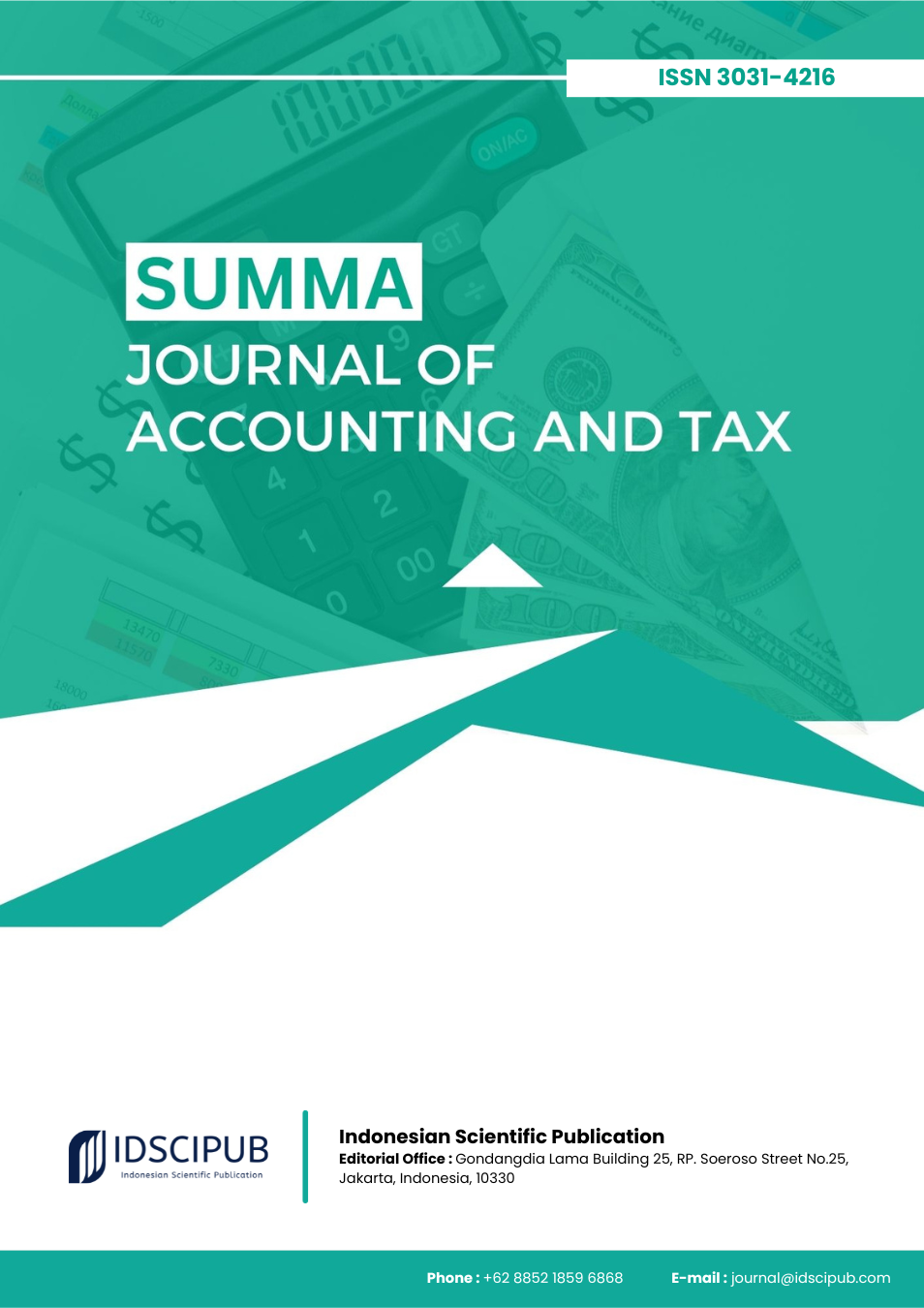Digital Tax Transformation and Corporate Compliance: Evidence from Indonesia’s e-Bupot Unification System
DOI:
https://doi.org/10.61978/summa.v2i4.886Keywords:
E-Bupot, Tax Compliance, Indonesia, Digital Taxation, SMEs, PJAP, Quasi-Experimental DesignAbstract
Indonesia has advanced digital tax reforms through the e-Bupot Unification system, mandated since April 2022, to centralize withholding tax reporting (PPh 4(2), 15, 22, 23/26). This study assesses its effectiveness in improving corporate compliance—timeliness, accuracy, and error reduction—during March–June 2024. Using a quasi-experimental before–after design, data were collected from e-Bupot logs, DJP e-filing records, and taxpayer registries for 250 corporations. Indicators included on-time filing, validity of submissions, and error rates. Analysis combined descriptive statistics, paired t-tests, and regression. Results show substantial progress: on-time filing rose from 74.2% to 88.6%, validity rates from 81.5% to 93.2%, while error rates declined from 6.4% to 2.1%. Regression confirmed significant effects of PJAP integration and firm size. Larger firms and PJAP users achieved stronger compliance, whereas SMEs improved modestly, limited by IT capacity. Sectoral differences emerged, with service and e-commerce outperforming manufacturing. Consistent with OECD and IMF findings, e-Bupot demonstrates digital platforms’ effectiveness in reducing compliance gaps. While the system benefits larger firms most, SMEs require training, infrastructure support, and simplified interfaces. Policymakers should expand PJAP partnerships, adopt sector-specific approaches, and invest in digital literacy to ensure equitable outcomes. This study provides empirical evidence from a developing economy, affirming digital reforms’ role in strengthening compliance and modernizing tax governance.
References
Arel‐Bundock, V., & Blais, A. (2023). Where Should Multinationals Pay Taxes? International Studies Quarterly, 67(2). https://doi.org/10.1093/isq/sqad012 DOI: https://doi.org/10.1093/isq/sqad012
Asqolani, A., Hidayat, R. T., Marsono, M., & Kalpikotomo, B. (2023). Internal Control in the Public Sector in Indonesia: A Case Study of State Tax Receivables Management. Ultimaccounting Jurnal Ilmu Akuntansi, 256–276. https://doi.org/10.31937/akuntansi.v15i2.3360 DOI: https://doi.org/10.31937/akuntansi.v15i2.3360
Boer, H.-W. d., & Jongen, E. (2021). Analysing Tax-Benefit Reforms in the Netherlands Using Structural Models and Natural Experiments. Journal of Population Economics, 36(1), 179–209. https://doi.org/10.1007/s00148-021-00852-3 DOI: https://doi.org/10.1007/s00148-021-00852-3
Büttner, T., & Thiemann, M. (2017). Breaking Regime Stability? The Politicization of Expertise in the OECD/G20 Process on BEPS and the Potential Transformation of International Taxation. Accounting Economics and Law - A Convivium, 7(1). https://doi.org/10.1515/ael-2016-0069 DOI: https://doi.org/10.1515/ael-2016-0069
Calinescu, Т., Ліхоносова, Г., & Зеленко, О. (2022). International Financial Activities: Accounting, Taxation and Insurance. Baltic Journal of Economic Studies, 8(2), 83–90. https://doi.org/10.30525/2256-0742/2022-8-2-83-90 DOI: https://doi.org/10.30525/2256-0742/2022-8-2-83-90
Cobham, A., & Jánský, P. (2018). Global Distribution of Revenue Loss From Corporate Tax Avoidance: Re‐estimation and Country Results. Journal of International Development, 30(2), 206–232. https://doi.org/10.1002/jid.3348 DOI: https://doi.org/10.1002/jid.3348
Damayanti, T. W., Nastiti, P. K. Y., & Supramono, S. (2020). Does Tax Amnesty Influence Intention to Comply?: If Students Are Taxpayers Already. Business Management and Education, 18(1), 1–13. https://doi.org/10.3846/bme.2020.10292 DOI: https://doi.org/10.3846/bme.2020.10292
Emmert-Fees, K., Capacci, S., Sassi, F., Mazzocchi, M., & Laxy, M. (2022). Estimating the Impact of Nutrition and Physical Activity Policies With Quasi-Experimental Methods and Simulation Modelling: An Integrative Review of Methods, Challenges and Synergies. European Journal of Public Health, 32(Supplement_4), iv84–iv91. https://doi.org/10.1093/eurpub/ckac051 DOI: https://doi.org/10.1093/eurpub/ckac051
Faisol, Moh., & Norsain, N. (2024). Enhancing Tax Compliance Through Digital Transformation: Evidence From Corporate Taxpayers’ Usage of E-Bupot. Jrak, 16(1), 159–168. https://doi.org/10.23969/jrak.v16i1.12614 DOI: https://doi.org/10.23969/jrak.v16i1.12614
FEBRINA, R., SARI, S., & SUSANTI, N. (2024). Pengaruh Penerapan E-Filling Dan E-Billing Terhadap Kepatuhan Wajib Pajak Orang Pribadi. Jurnal Akuntansi Dan Keuangan, 13(1), 8–17. https://doi.org/10.32520/jak.v13i1.3590 DOI: https://doi.org/10.32520/jak.v13i1.3590
Gottlieb, A., Charles, P., McLeod, B. A., Kjellstrand, J., & Bonsu, J. E. (2020). Were California’s Decarceration Efforts Smart? A Quasi-Experimental Examination of Racial, Ethnic, and Gender Disparities. Criminal Justice and Behavior, 48(1), 116–134. https://doi.org/10.1177/0093854820923384 DOI: https://doi.org/10.1177/0093854820923384
Hesami, S., Jenkins, H., & Jenkins, G. P. (2024). Digital Transformation of Tax Administration and Compliance: A Systematic Literature Review on E-Invoicing and Prefilled Returns. Digital Government Research and Practice, 5(3), 1–20. https://doi.org/10.1145/3643687 DOI: https://doi.org/10.1145/3643687
Hidayanto, D. K., Aprilia, S., & Nababan, N. (2023). The Role of E-Filing, Perceived Ease of Use, and Perceived Usefulness in Improving Corporate Taxpayer Compliance. Jurnal Akuntansi Dan Manajemen, 20(1), 58–66. https://doi.org/10.36406/jam.v20i01.872 DOI: https://doi.org/10.36406/jam.v20i01.872
Hong, S., Serfes, K., & Thiele, V. (2020). Competition in the Venture Capital Market and the Success of Startup Companies: Theory and Evidence. Journal of Economics & Management Strategy, 29(4), 741–791. https://doi.org/10.1111/jems.12394 DOI: https://doi.org/10.1111/jems.12394
I Gusti Agung Ayu Ngr. Garnetia Pramanita, & Rasmini, N. K. (2020). Sistem E-Filing Dan Kepatuhan Wajib Pajak Orang Pribadi: Studi D&M IS Success Model Pada KPP Pratama Denpasar Timur. E-Jurnal Akuntansi, 30(11), 2825. https://doi.org/10.24843/eja.2020.v30.i11.p09 DOI: https://doi.org/10.24843/EJA.2020.v30.i11.p09
Irawati, Subagiyo, A., Abidin, N., & Yuniati. (2023). Analysis of the Effectiveness of the Implementation of E-Bupot 23/26 to Improve Taxpayer Compliance (Case Study at PT Surya Energy Anugerah Lestari 2020–2021). 178–184. https://doi.org/10.2991/978-2-38476-104-3_20 DOI: https://doi.org/10.2991/978-2-38476-104-3_20
Izzah, N. R., & Istiqomah, D. F. (2023). Technology Acceptance Model: Determinans Actual System Use of E-Bupot Unification Applications. Jurnal Akademi Akuntansi, 6(1), 44–62. https://doi.org/10.22219/jaa.v6i1.25745 DOI: https://doi.org/10.22219/jaa.v6i1.25745
Jannah, M., & Sitinjak, N. D. (2023). Faktor-Faktor Yang Mempengaruhi Tingkat Kepatuhan Wajib Pajak Orang Pribadi Pelaku E-Commerce Di Kota Labuan Bajo. Jurnal Ilmiah Bisnis Dan Perpajakan (Bijak), 5(2), 113–120. https://doi.org/10.26905/j.bijak.v5i2.10013 DOI: https://doi.org/10.26905/j.bijak.v5i2.10013
Karina, M., & Simanjuntak, B. (2022). Efektivitas Penggunaan E-Bupot 23/26. Media Riset Akuntansi Auditing & Informasi, 22(1), 157–170. https://doi.org/10.25105/mraai.v22i1.12627 DOI: https://doi.org/10.25105/mraai.v22i1.12627
Lannai, D. (2024). Effectiveness and Efficiency of the E-Filing System in Enhancing Taxpayer Compliance. Owner, 8(4), 4838–4849. https://doi.org/10.33395/owner.v8i4.2507 DOI: https://doi.org/10.33395/owner.v8i4.2507
Meilita, S., & Pohan, H. T. (2022). Pengaruh Kesadaran Wajib Pajak, Sanksi Perpajakan, Dan E-Filing Terhadap Kepatuhan Wajib Pajak Orang Pribadi Di KPP Kelapa Gading Jakarta. Jurnal Ekonomi Trisakti, 2(2), 1165–1178. https://doi.org/10.25105/jet.v2i2.14494 DOI: https://doi.org/10.25105/jet.v2i2.14494
Meiryani, M., Alkhanifani, D., & Ramadhanti, V. (2023). The Effect of E-System Modernization, Self Efficacy and Digital Literacy Capabilities on Taxpayer Compliance. E3s Web of Conferences, 426, 01020. https://doi.org/10.1051/e3sconf/202342601020 DOI: https://doi.org/10.1051/e3sconf/202342601020
Meng, L., Yuan, X., Cao, X., & Zhang, Z. (2019). The Gut-Brain Axis in the Pathogenesis of Parkinson’s Disease. Brain Science Advances, 5(2), 73–81. https://doi.org/10.1177/2096595820902566 DOI: https://doi.org/10.1177/2096595820902566
Nurchamid, M., & Sutjahyani, D. (2018). Pengaruh Penerapan Sistem E-Filing, E-Billing Dan Pemahaman Perpajakan Terhadap Kepatuhan Wajib Pajak Pada Kantor Pelayanan Pajak Pratama Surabaya Tegalsari. Jea17 Jurnal Ekonomi Akuntansi, 3(02). https://doi.org/10.30996/jea17.v3i02.3184 DOI: https://doi.org/10.30996/jea17.v3i02.3184
OECD. (2023). SMEs in the Era of Hybrid Retail. https://doi.org/10.1787/882f30b0-en DOI: https://doi.org/10.1787/882f30b0-en
Otekunrin, A. O., Nwanji, T. I., Eluyela, D. F., Inegbedion, H., & Eleda, T. (2021). E-Tax System Effectiveness in Reducing Tax Evasion in Nigeria. Problems and Perspectives in Management, 19(4), 175–185. https://doi.org/10.21511/ppm.19(4).2021.15 DOI: https://doi.org/10.21511/ppm.19(4).2021.15
Pujiastuti, H., & Bawazier, S. (2021). Analysis of E-Bupot System Implementation on Taxpayer Satisfaction. Management Research Studies Journal, 2(2), 100–106. https://doi.org/10.56174/mrsj.v2i2.425 DOI: https://doi.org/10.56174/mrsj.v2i2.425
Putri, A. H., & Ekowati, L. (2023). Implementation of E-Bupot Unifikasi for Income Tax Article 23 at Xyz Apartment Management Agency. Journal of Applied Sciences in Accounting Finance and Tax, 6(2), 79–89. https://doi.org/10.31940/jasafint.v6i2.79-89 DOI: https://doi.org/10.31940/jasafint.v6i2.79-89
Rendy, R., & Irawati, W. (2019). UNDERSTANDING OF TAX RULES, TAX TARIFFS AND TAX-RIGHTS CONSCIOUSNESS ON E-Commerce USERS TAX COMPLIANCE. Eaj (Economics and Accounting Journal), 2(2), 141–148. https://doi.org/10.32493/eaj.v2i2.y2019.p141-148 DOI: https://doi.org/10.32493/eaj.v2i2.y2019.p141-148
Setiorini, H., & Yusmaniarti, Y. (2020). Faktor-Faktor Yang Mempengaruhi Penggunaan Fasilitas E-Filling Dalam Penyampaian SPT Masa Oleh Wajib Pajak Di Kota Bengkulu. Jurnal Ilmiah Akuntansi Manajemen Dan Ekonomi Islam (Jam-Ekis), 3(1). https://doi.org/10.36085/jam-ekis.v3i1.519 DOI: https://doi.org/10.36085/jam-ekis.v3i1.519
Sinen, K., & Zainuddin, Z. (2021). Taxpayer Awareness, Application of Electronic Systems, and Understanding of Taxpayers’ Compliance With Tax Laws and Regulations Regarding Their Risk Appetite Level as Moderating Variables. Bongaya Journal for Research in Accounting (Bjra), 4(2), 61–73. https://doi.org/10.37888/bjra.v4i2.317 DOI: https://doi.org/10.37888/bjra.v4i2.317
Yudha, C. K., & Putra, I. M. W. (2023). E-System Perpajakan Pada Kepatuhan Wajib Pajak Dimediasi Oleh Variabel Locus of Control. E-Jurnal Akuntansi, 33(4), 1143. https://doi.org/10.24843/eja.2023.v33.i04.p19 DOI: https://doi.org/10.24843/EJA.2023.v33.i04.p19







